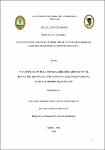| dc.contributor.advisor | Espíritu Pezantes, Jorge Miguel | |
| dc.contributor.author | Del Castillo Mozombite, Denilson Marcell | |
| dc.date.accessioned | 2017-02-27T15:41:00Z | |
| dc.date.available | 2017-02-27T15:41:00Z | |
| dc.date.issued | 2016 | |
| dc.identifier.uri | http://repositorio.unapiquitos.edu.pe/handle/20.500.12737/4166 | |
| dc.description.abstract | El estudio se realizó en un bosque de terraza media del arboretum “El Huayo” del Centro de Investigación y Enseñanza Forestal Puerto Almendra en Iquitos, Perú. El objetivo fue realizar el censo forestal, estimar la biomasa aérea total y determinar el modelo alométrico que estima la mayor cantidad de biomasa. En el área de estudio se han registrado en total 60 especies, 63 géneros, 30 familias y 437 árboles; además la familia Fabaceae reporta el más alto número de especies con un total de once, le siguen en importancia la familia Myristicaceae con cinco especies respectivamente. Las especies que reportan la mayor cantidad de biomasa estimada con un total de 131,99 t/ha le corresponde al modelo alométrico sugerido por Brown et al. (1989), el modelo alométrico propuesto por Higuchi y Carvalho (1994) con 0,135 t/ha y la biomasa estimada por modelo alométrico de Chave et al. (2005) es de 3,820 t/ha, y el modelo se ajustó a la distribución de regresión lineal múltiple; asimismo, el modelo alométrico sugerido por Chave et al. (2005) ostenta el más alto coeficiente de determinación (0,88) y el menor valor reportan los modelos alométricos indicados por Brown et al. (1989) e Higuchi y Carvalho (1994) con 0,85 respectivamente. Se acepta la hipótesis alterna en el sentido de que la cantidad de biomasa estimada varía según el modelo alométrico utilizado. | es_PE |
| dc.description.abstract | The aim of this study was to evaluate the aboveground biomass (AGB) in a mid-terrace forest of the arboretum “El Huayo” located in the CIEFOR Puerto Almendra, Loreto, Peru by using three allometric equations. A forest census allowed registering DBH and height of all trees with DBH ≥ 10 cm as well as the floristic composition of the forest. Sixty species, 63 genera and 437 tree individuals were registered and families with the highest number of species were Fabaceae (11) and Myristicaceae (5). The highest AGB of 131,99 t/ha was estimated with the Brown et al. model (1989) while with the Higuchi and Carvalho (1994) and the Chave et al. (2005) models, 0,13 t/ha and 3.82 t/ha of AGB were estimated. The Chave et al. model adjusted well to the multiple lineal regression distribution with R2 = 0,88, while the Brown et al. and Higuchi and Carvalho models reached an R2 = 0,85, concluding that the amount of AGB estimates varies with the allometric model. | en_US |
| dc.description.uri | Tesis | es_PE |
| dc.format | application/pdf | es_PE |
| dc.language.iso | spa | es_PE |
| dc.publisher | Universidad Nacional de la Amazonía Peruana | es_PE |
| dc.rights | info:eu-repo/semantics/openAccess | es_PE |
| dc.rights | Attribution-NonCommercial-NoDerivs 3.0 United States | * |
| dc.rights.uri | http://creativecommons.org/licenses/by-nc-nd/3.0/us/ | * |
| dc.source | Universidad Nacional de la Amazonía Peruana | es_PE |
| dc.source | Repositorio Institucional - UNAP | es_PE |
| dc.subject | Biomasa | es_PE |
| dc.subject | Cuantificación | es_PE |
| dc.subject | Censos | es_PE |
| dc.title | Cuantificación de la biomasa aérea del Arboretum "El Huayo" del Centro de Investigación y Enseñanza Forestal Puerto Almendra, Iquitos, 2015 | es_PE |
| dc.type | info:eu-repo/semantics/masterThesis | es_PE |
| thesis.degree.discipline | Agronomía | es_PE |
| thesis.degree.grantor | Universidad Nacional de la Amazonía Peruana. Escuela de Posgrado | es_PE |
| thesis.degree.level | Maestría | es_PE |
| thesis.degree.name | Magister en Ciencias en Gestión Ambiental | es_PE |
| thesis.degree.program | Regular | es_PE |


